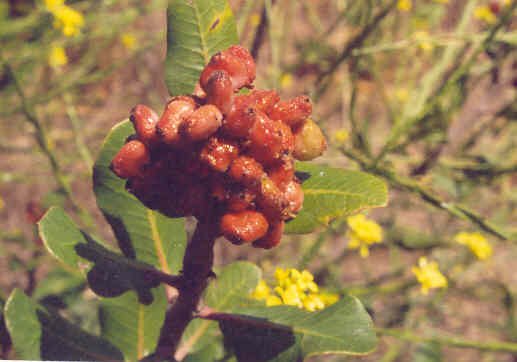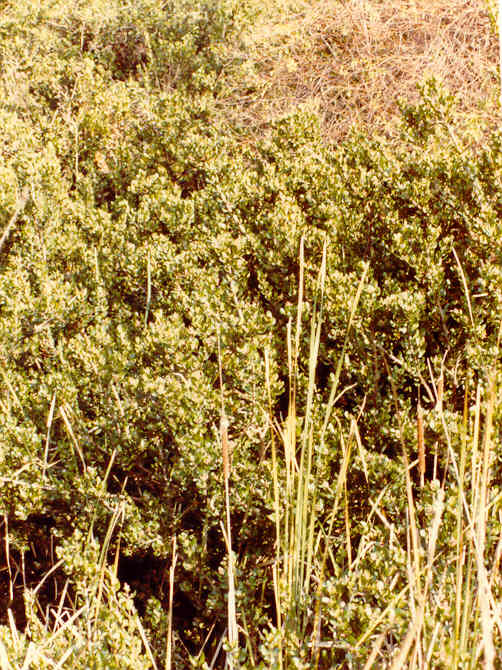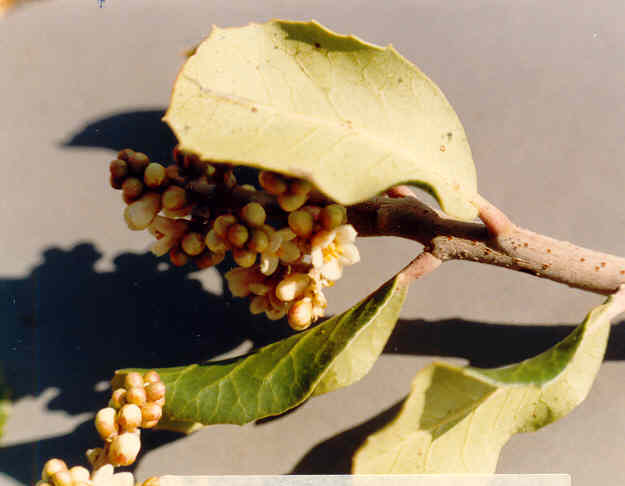
 |
Rhus integrifolia (Nutt.) Brewer & S. WatsonAnacardiaceae (Sumac Family)NativeLemonadeberryMahoganyCoast Sumac |
June Photo
Plant Characteristics:
Rounded aromatic shrub, 1-3 m. high,
with finely pubescent, +/- reddish
stoutish twigs; lvs. coriaceous, flat, subentire or with shallow sharp teeth,
oblong-ovate, rounded-obutse at both ends, subglabrous, 2.5-5 cm. long, 2-3 cm.
wide; sometimes +/- lobed; petioles 3-6 mm. long; fls. in close panicles, rose
to white, subtended by roundish hairy bracts; petals ciliolate, ca. 3 mm. long,
drupe viscid, acid, pubescent, reddish, flattened, ca. 10 mm. in diam.; stone
flat, ca. 7 mm. long.
Habitat:
Ocean bluffs and canyons, dry places under 2600 ft.; inland to w.
Riverside Co.; Coastal Sage Scrub, Chaparral; Santa Barbara Co. to L. Calif.;
Channel Ids. Feb.-May.
Name:
Greek, rhous, ancient name for
sumac. (Munz, Flora
So. Calif. 64). Integrifolia
means that the leaf margin is not toothed.
(Dale 42).
General:
Common in the study area. Photographed
specimens are along and above Back Bay Dr. between Big Canyon and Eastbluff Dr.
and on the east side of the Delhi Ditch. (my
comments). Used
in making a drink, the berries were soaked in water and the fine hairs strained
out. Indians dried the berries for
preservation, then soaked them in water and
heated them for a form of hot pink lemonade. The Cahuillas used a tea of the leaves as a treatment for
coughs and colds. The berries make
a pleasantly tart snack if placed in the mouth right off the bush.
The fruit is eaten by Mountain Quail, Crow, Red-shafted Flicker, Scrub
Jay and Cactus Wren. (Clarke 52).
There are a number of examples of chemical compounds in chaparral plants
that may play important roles in restricting herbivory.
Many of us have experienced the effectiveness of phenolic compounds in
poison oak called resorcinols. Lemonadeberry,
sugar bush, and laurel sumac all contain related compounds called catechols,
which may also cause dermatitis in highly sensitive individuals.
Pungent turpentines are characteristic of many groups of coastal sage
scrub species, particularly members of the mint and sunflower families.
Most legumes have either highly toxic alkaloids or similarly toxic
non-protein amino acids. All of
these compounds, produced at a significant metabolic rate, are thought to reduce
potential herbivory and related damage by pathogens. (Rundel, Philip W. "Structure
and Function in California Chaparral."
FREMONITA, A Journal of the California Native Plant Society.
p. 9). See Heteromeles
arbutifolia, for additional information on the subject. Delfina Cuero, a Kumeyaay or
Southern Diegueno Indian, made the following comments about Rhus
integrifolia in her autobiography: "The
name used depended upon the berry color red (huusill)
or orange (huutat); the berries were eaten fresh or soaked to flavor water; the
seed (keha) was ground and used with
fruit for tea. We also ground the
seeds to drink when sick and feverish. The
bark was also made into a tea to use after a baby was born."
(Shipek 95). In California there are 6
species of Rhus. (Robbins et al.
292). The
wood of these shrubs is of a dark-red color, which is responsible for the common
name "mahogany". (Parsons
209). The
Northern Diegueno Indians kept a wad of Rhus integrifolia leaves in their
mouth to lessen thirst on long foot journeys.
(Campbell 141).
Text Ref:
Abrams, Vol. III 51; Hickman, Ed. 135; Munz, Calif.
Flora 998; Munz, Flora So.
Calif. 64.
Photo Ref:
Dec 1 82 # 30 A; Jan 1 84 # 15; Feb 2 84 # 5.
Identity: by R. De Ruff,
confirmed by F. Roberts.
First Found: December 1982.
Computer Ref: Plant Data 129.
Have plant specimen.
Last edit 6/12/05.
 |
 |
December Photo February Photo